Occasionally a gun comes along that revolutionizes the industry. It’s not always the first of its kind, but it has something special that captures the imagination of shooters and provides such an amazing leap forward that other manufacturers rush to imitate and improve it.
When Smith & Wesson introduced the Shield in mid-2012, it was exactly that kind of gun.
Looking to dominate the concealed carry market, S&W dropped this single-stack, striker-fired pistol on the market – and it became an instant success.
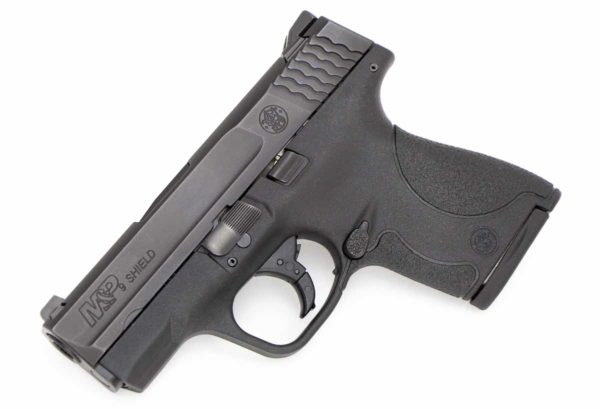
Where to buy the Smith & Wesson Shield
The original Shield has been updated to the Shield M2.0. and the higher capacity Shield Plus. The new guns are nothing but improvements on the top-tier performance of the original. I recommend using one of our affiliate links below to purchase one.
- Palmetto State Armory: Shield M2.0, Shield Plus, Shield Plus EDC Kit
- Guns.com: Shield M2.0
- Sportsman’s Guide: Shield Plus
Strangely, it was not the first of its kind on the market…nor the second. But, that didn’t matter. The Shield had just the right combination of looks, features, price and brand recognition that propelled it to incredible success out of the gate.
Today, I take a look at the updated gun in this Smith & Wesson 9mm Shield review.
General Information
As the concealed carry market matured, the draw of the single stack pistol strengthened. Smith & Wesson stepped into this niche in 2012 with the M&P Shield.
The gun was an instant hit.
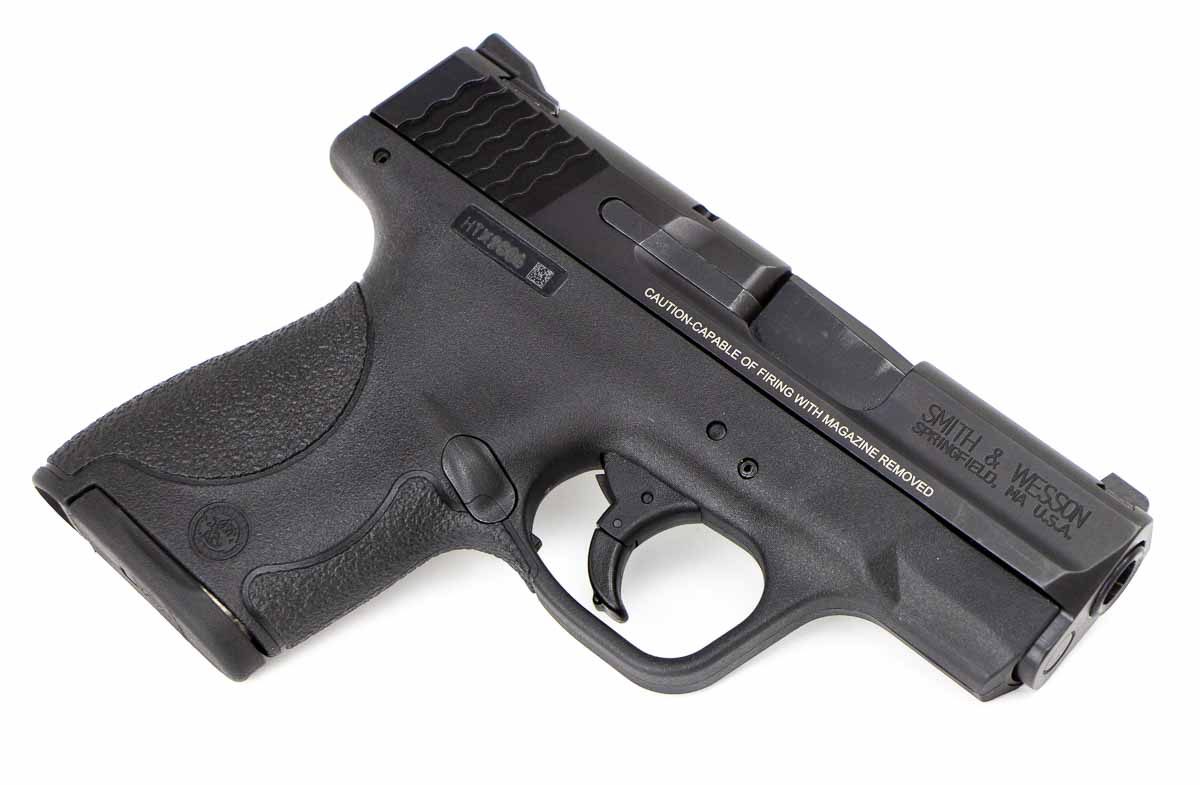
However, Smith & Wesson elected to design the pistol with a small thumb safety – something many people did not want. So, two years later, S&W offered the Shield without the lever. These guns were also an overnight sensation.

I picked up a Smith and Wesson M&P9 Shield without the thumb in July of 2014 and have been running it pretty hard ever since then.
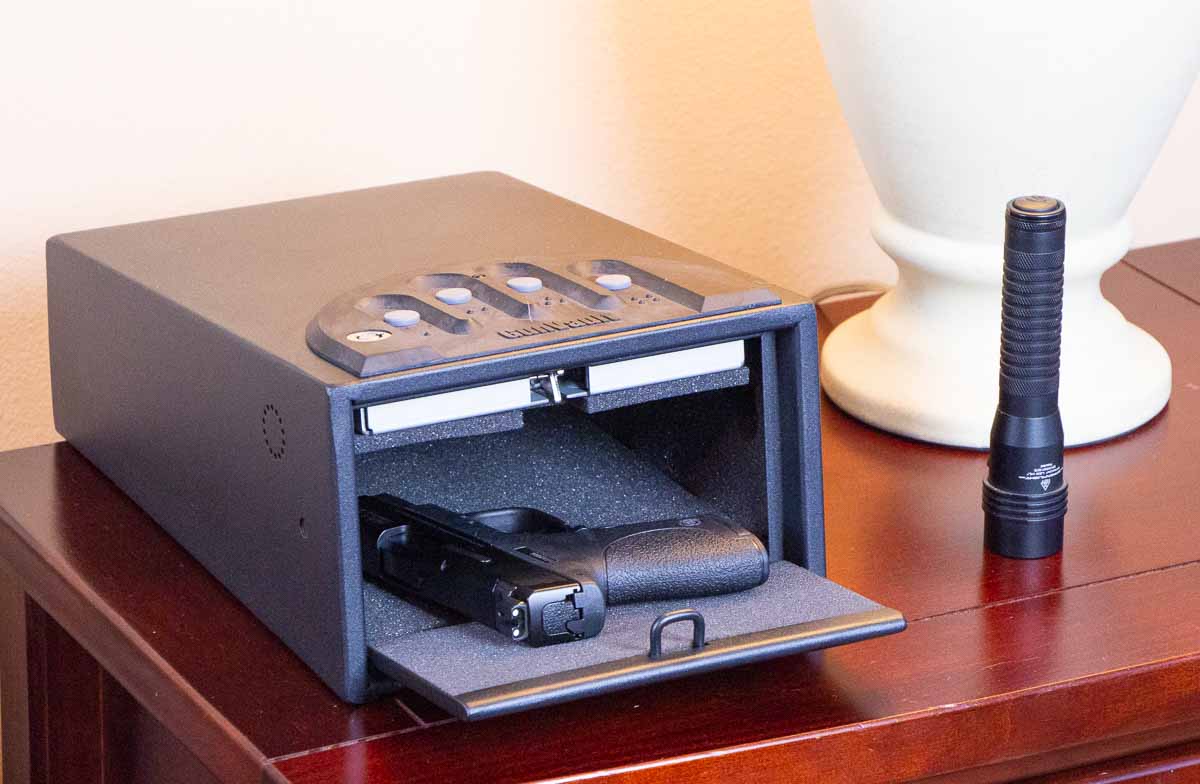
There have been two model upgrades to the Shield line since then – the M2.0 and the Plus. I’ll touch on those in a minute. I hope that this review will still be useful to you.
Features
At its core, the Shield is a polymer-framed, striker-fired pistol. The pistol falls into the broad category of compact handguns. It has a 3.1″ barrel and is quite thin.
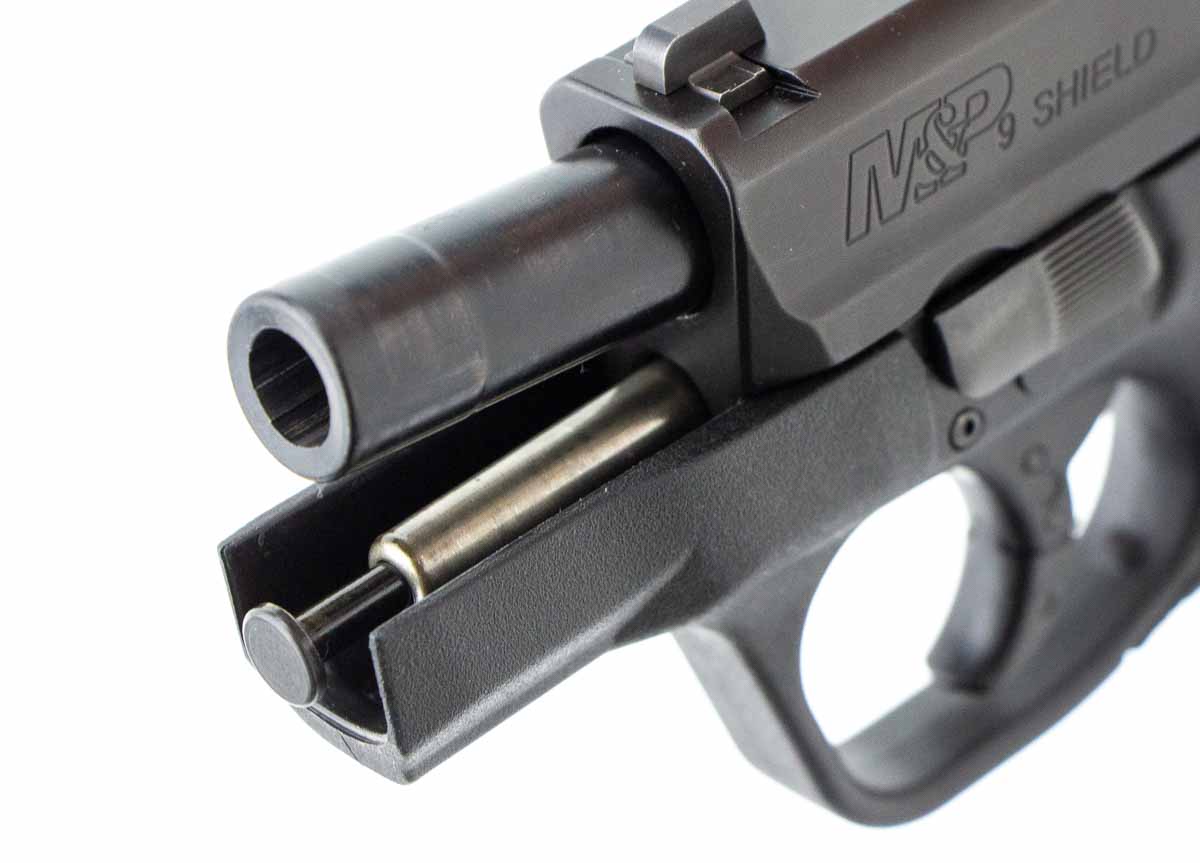
Less than 1″ thick, the 9mm Shield is considered to be an ideal width by some for concealed carry. After all, a thin gun is easier to conceal than a thick one.
Part of the reason Smith & Wesson’s design team was able to make it so thin is that the magazines are single stacked. This reduces potential capacity but also keeps the width to a minimum.
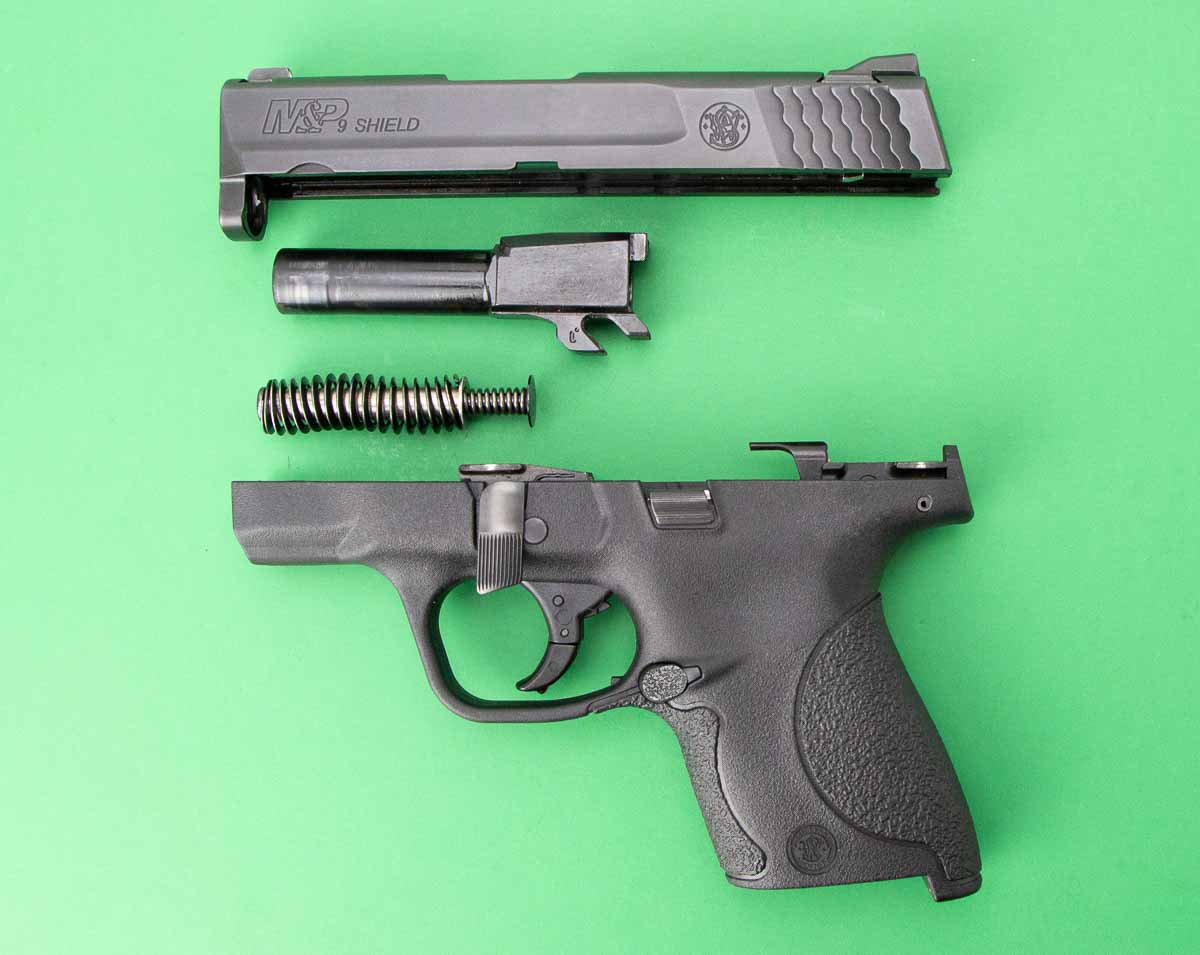
The 9mm version ships with two magazines. One is a flush-fitting 7-round model, while the other is an extended mag that holds 8 rounds. Specific details on the extended magazine are listed in the shooting section below.
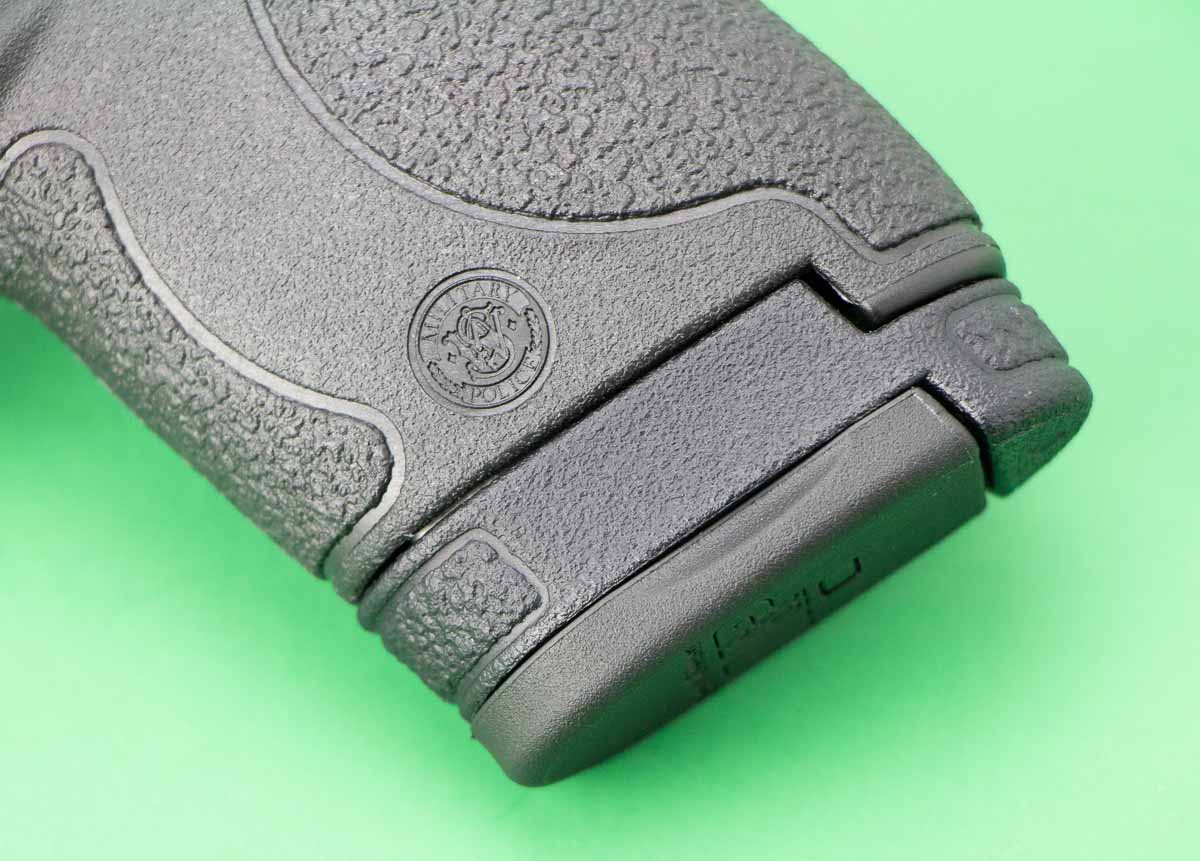
As I explained earlier in the article, I am reviewing the 9mm Shield that does not have an external safety. However, Smith & Wesson offers other versions with a thumb safety if that is important to you.
No Safety
When the Shield rolled out at the 2012 NRA show, the gun had a tiny thumb safety as a standard feature. Some people liked the safety, but many people did not. Responding to consumer demand, Smith & Wesson released a “safety-less” version of the gun in 2014.
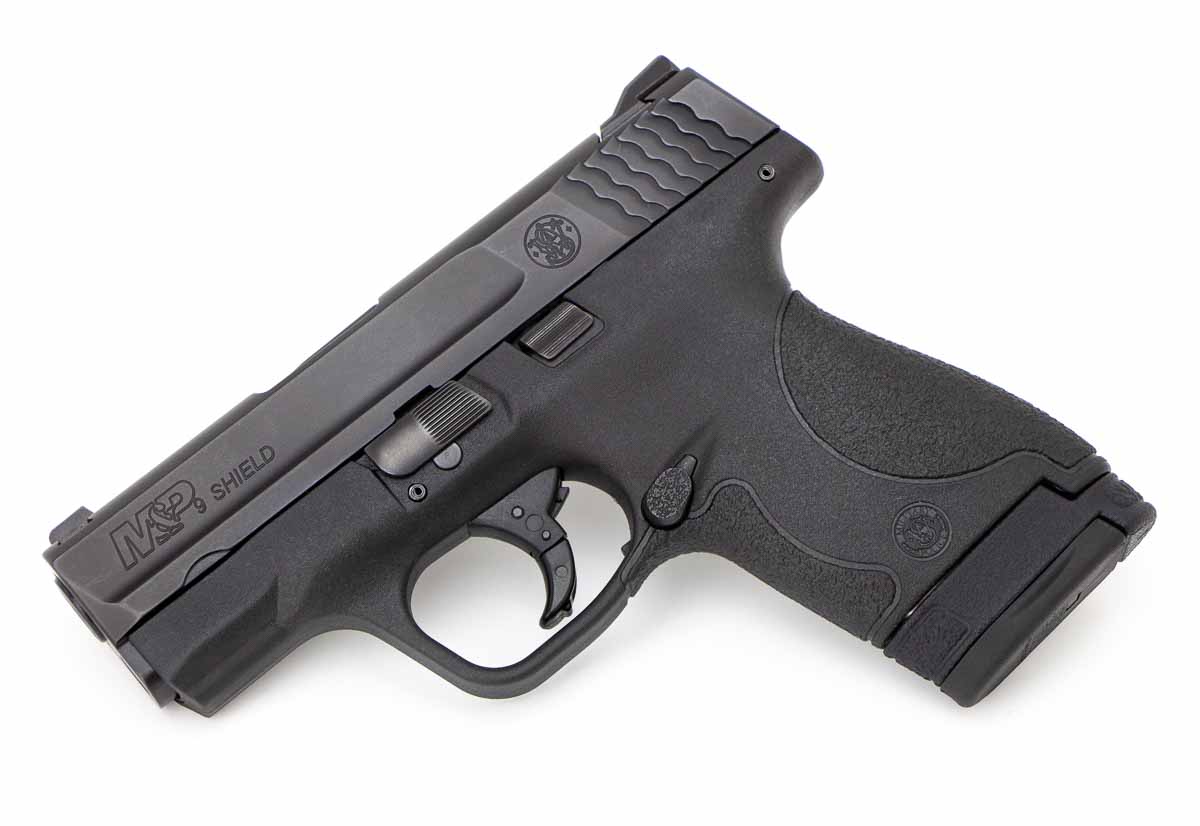
As most readers will realize, the M&P Shield still has multiple safeties to help prevent accidental discharges. The only thing removed from the new guns is the small thumb safety located on the rear portion of the gun’s frame.
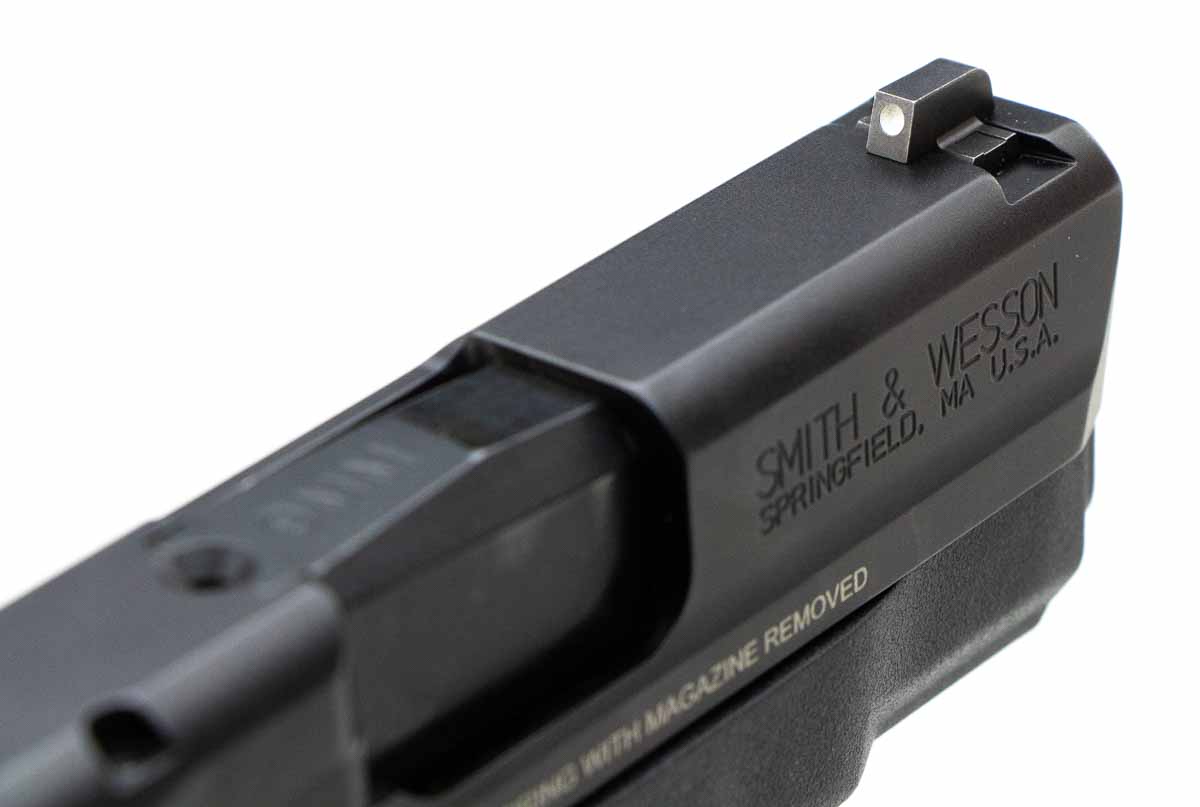
There is a reasonable concern by some shooters and trainers that the safety may be engaged accidentally while being carried. Should a user pull the gun to defend against an attack, the safety could slow the response to the threat.
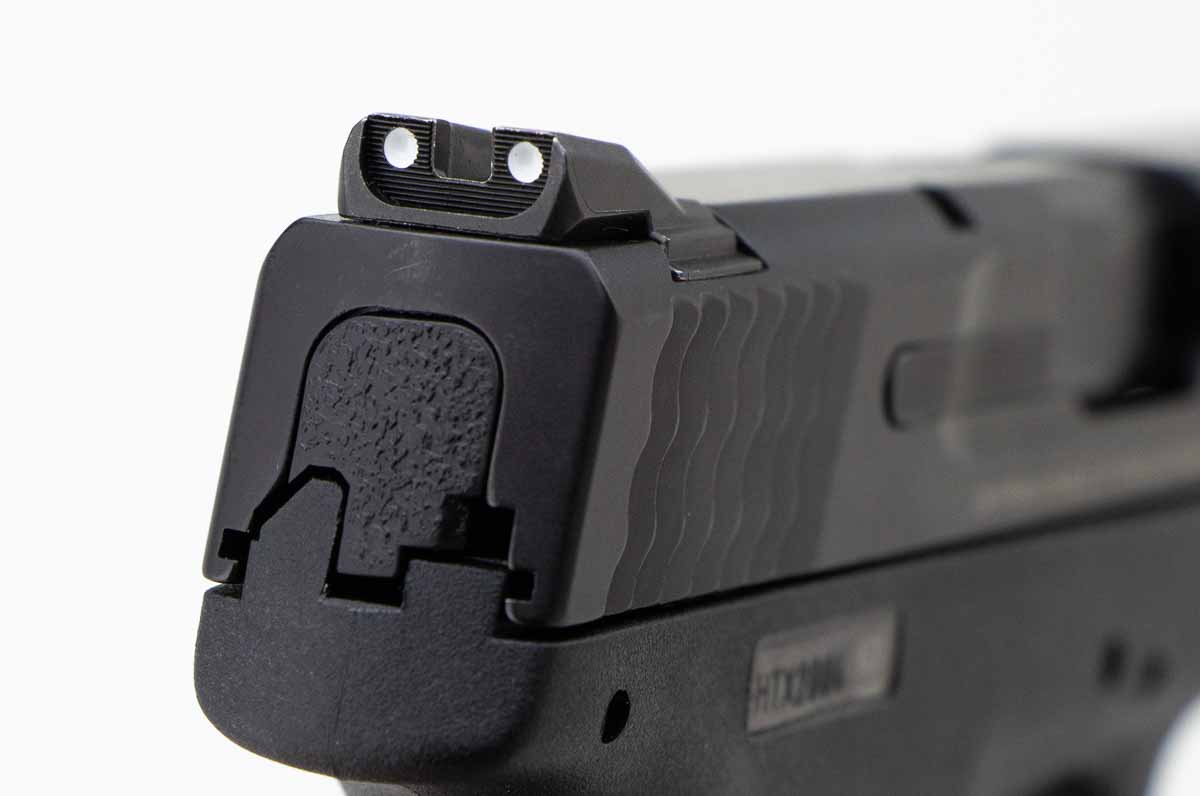
While that might seem like a far-fetched scenario, I have spoken to trainers who have seen safeties accidentally engaged in training. This would suggest that the problem is not as far-fetched as one might assume.
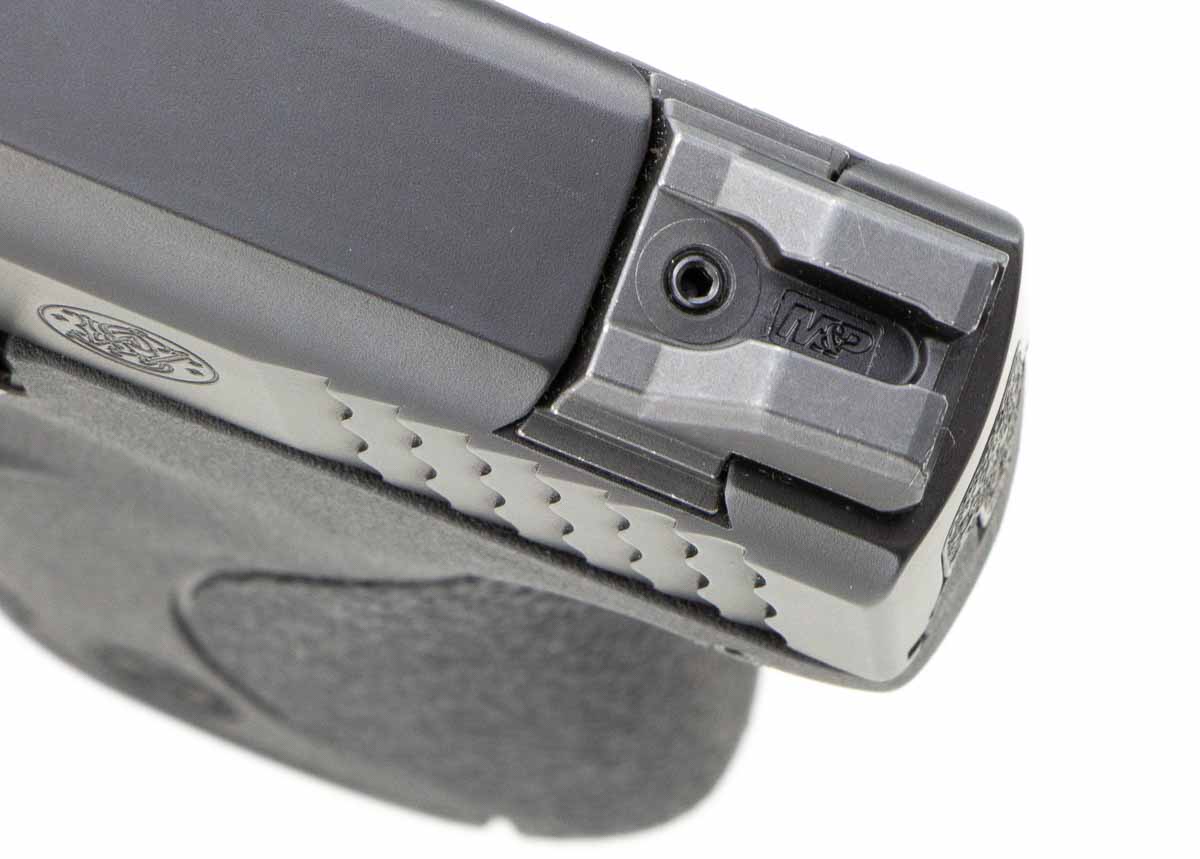
I was concerned that Smith & Wesson might simply plug the hole on the existing Shield frame when they released the new guns. However, the company appears to run a separate frame for these pistols so there is no hole, plug or other blemish indicating where the safety might have otherwise gone. Well done, S&W.
Trigger
When the M&P Shield was announced, Smith & Wesson stated the guns would have an enhanced trigger. The original M&P pistols, both full size and compact, were well received by the public. However, many people did not like the triggers and turned to companies like Apex Tactical for trigger enhancement kits.
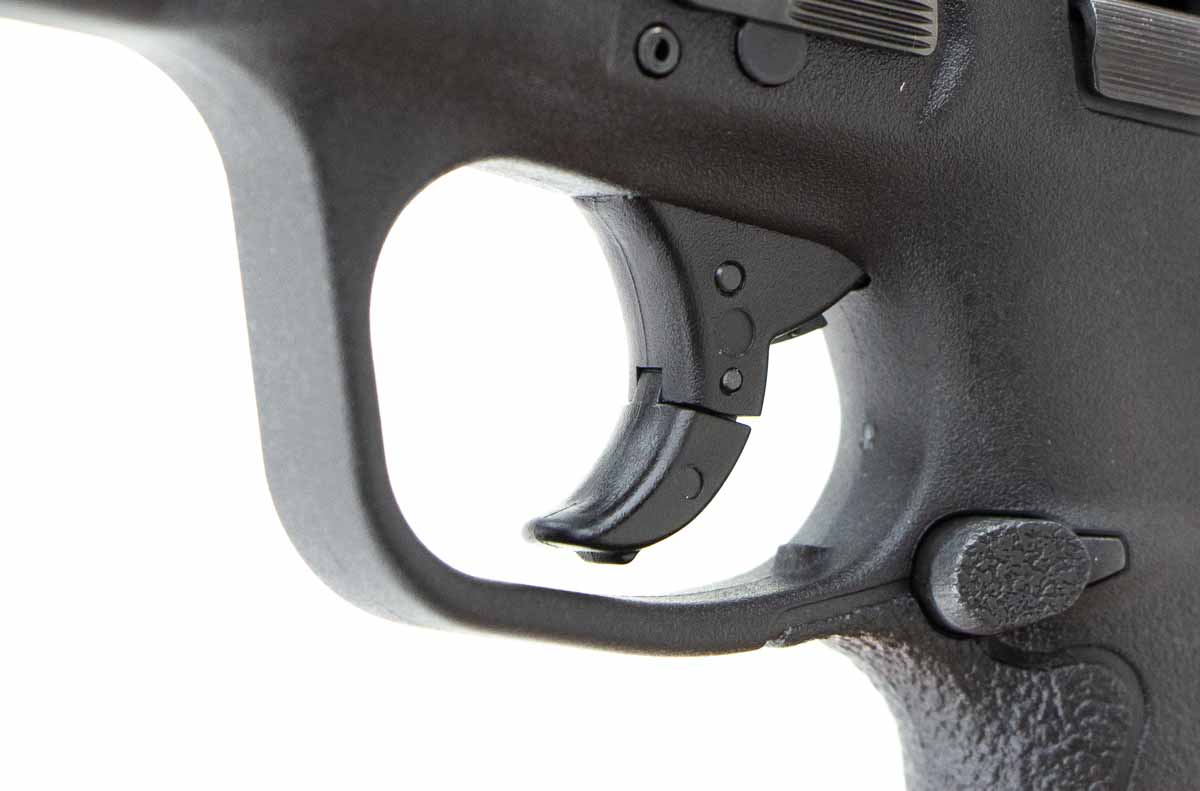
I was curious to feel the difference between my original M&P9 and the 9mm Shield.
Based purely on feel, the original M&P9 trigger has a soft, almost spongy, take up with a clean break. The reset is soft and easily missed. The Shield, on the other hand, has a short take up with a heavier pull to break.
I whipped out my Lyman digital trigger pull gauge and ran a series of 10 pulls on each gun. The numbers reflected what I felt: the full-size M&P9 averaged 5 pounds, 5.5 ounces while the Shield averaged 7 pounds 3.5 ounces.
Specifications
Here are the Smith & Wesson 9mm Shield specs:
| Caliber | 9mm |
| Magazine Capacity | 7 |
| Weight | 19.0 oz |
| Barrel Length | 3.1″ |
| Overall Length | 6.1″ |
| Width | 0.9″ |
| Sights | 3-dot |
| Action | striker-fired |
| SKU | 10035 |
| MSRP at Launch | $449 |
In the Wild
Specs and marketing hype notwithstanding, the real test of a self-defense gun’s usefulness is on the range and on the street.
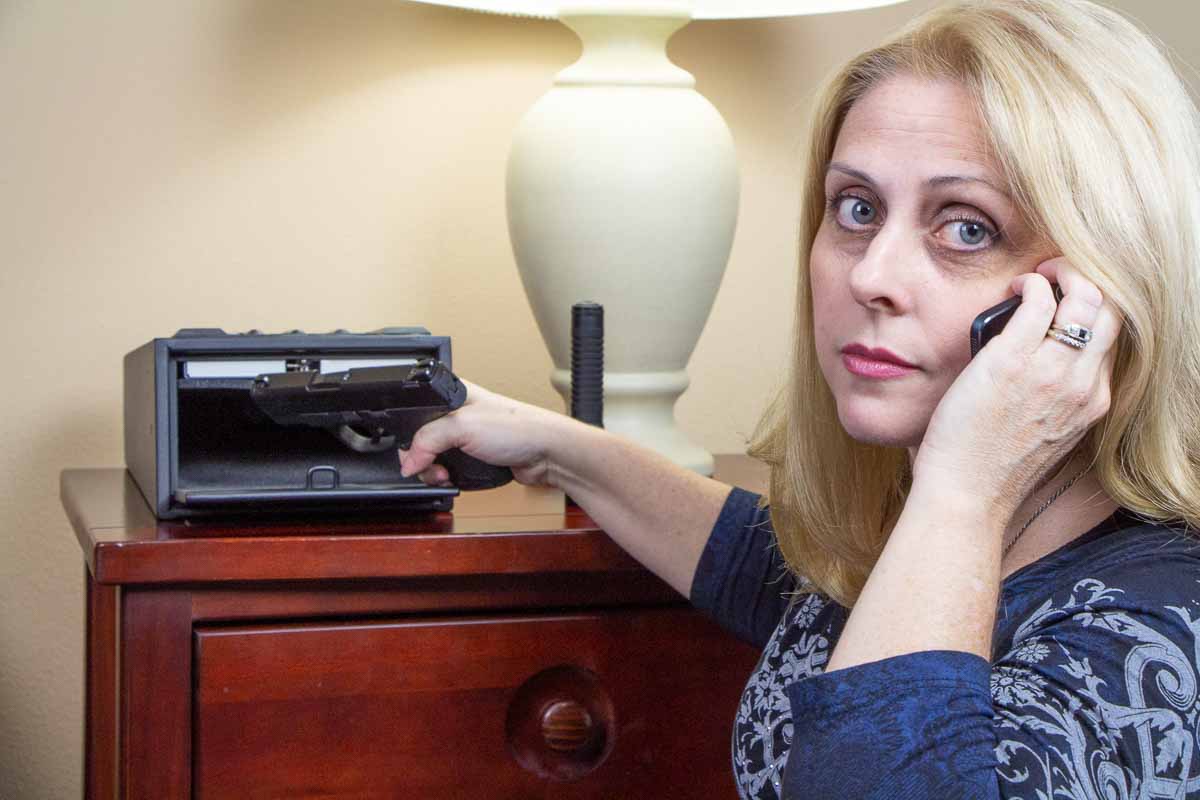
If the gun isn’t reliable and accurate or is just a pain in the butt to carry, I don’t have much use for it in a self-defense role.
I’m happy to say the Smith and Wesson M&P Shield delivered.
On the Range
It’s been more than 7 years since I purchased this pistol. I’ve carried it a lot and shot it a bunch. It has been extremely reliable with good accuracy and mild recoil.
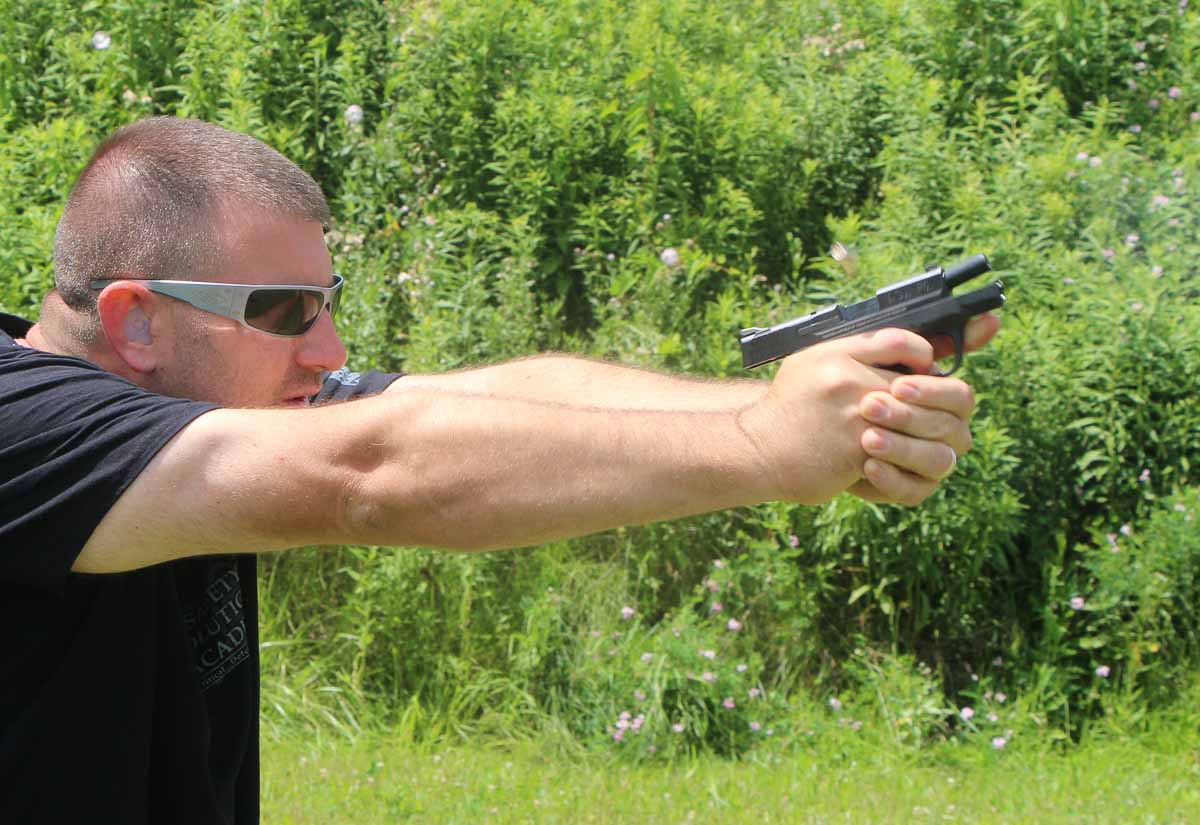
After I picked it up, I got the 9mm Shield to the range a few times to break it in. Then I really wrung it out with some friends and trainers in Ohio that summer.
Among the folks who ran this gun in Ohio were Paul Carlson of the Safety Solutions Academy, Grant Cunningham of the Personal Security Institute, and a number of local cops and shooters.
We ran the Shield with at least 12 different kinds of ammunition. There were at least four different shooters (not including me) of varying hand sizes and experience that ran the gun. Across the board, everyone agreed that shooting the Shield was a breeze.
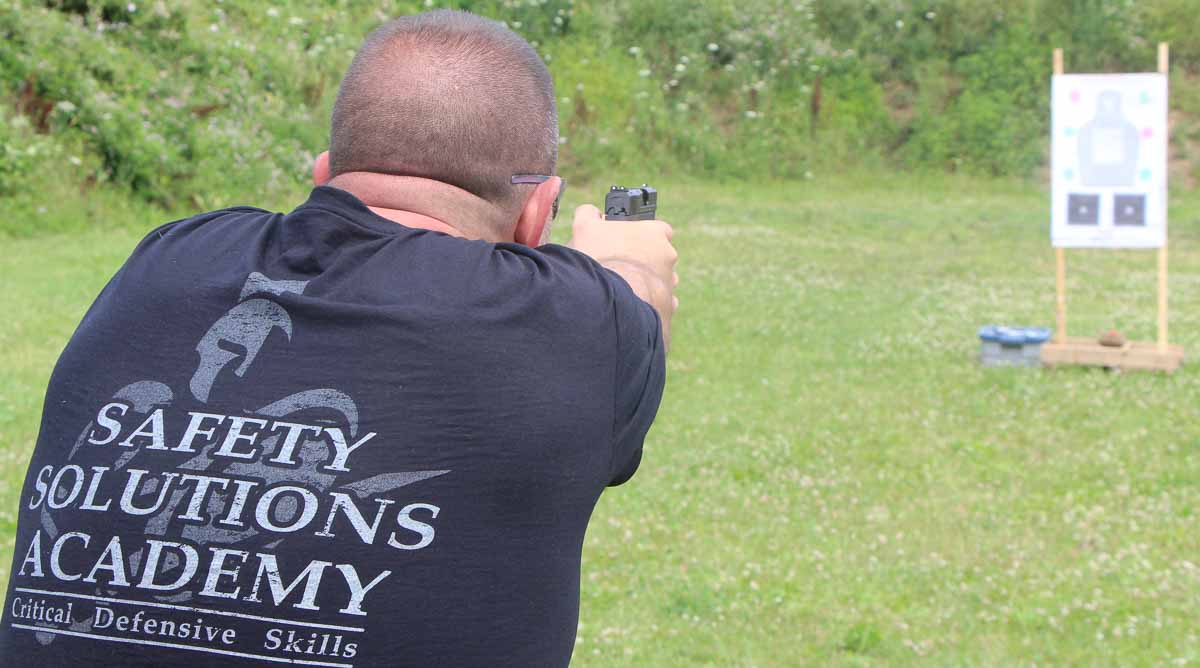
The best part was it ran without any malfunction of any kind.
Since that initial range time, I’ve had the Shield on the firing line many times. It has continued to work without any problems at all. I haven’t kept track of a round count, but more than 7,000 rounds through the Shield seems to be a conservative estimate.
Accuracy
Regular readers of this site will know that I don’t measure and report group sizes. Frankly, my shooting skill has a larger influence on accuracy that the gun. Saying that I shot a x” group at y yards doesn’t really tell you much about the gun, just how I was shooting that day. Frankly, my shooting skill does not approach the potential accuracy of most firearms.
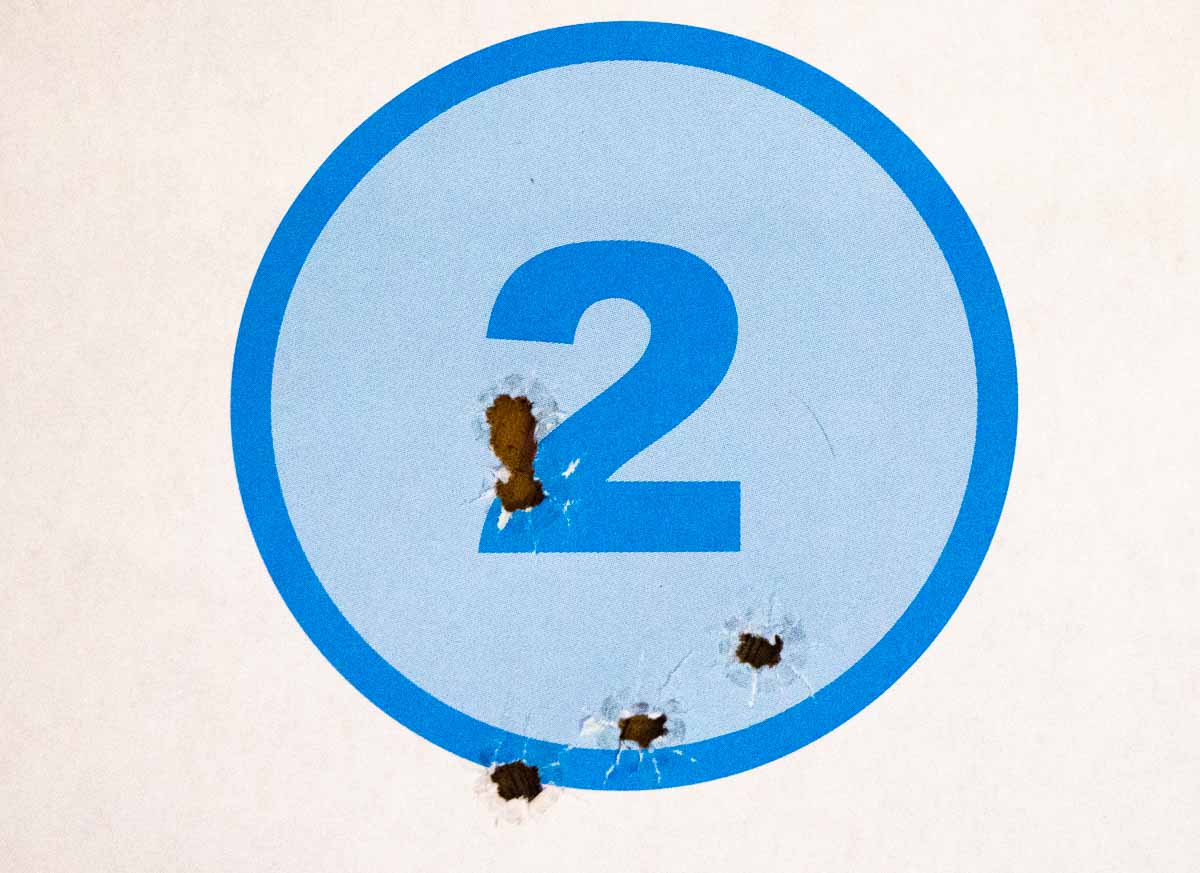
I like to test a gun’s practical accuracy by making sure I can put all rounds in an 8″ target at 25 yards and rapidly fire a magazine into the same size target at 7 yards. If the gun can do those things, then I am reasonably sure it will be accurate enough for self-defense.
As I mentioned, I was at a range in Cleveland. New to the facility, I started shooting an 8″ metal gong at the end of the pistol range. It looked a little longer than 25 yards, but I wasn’t sure of the distance. After hitting the gong nearly 100% with two magazines, I discovered the distance was just under 50 yards. I figure that is more than good enough for my needs.
Recoil and Feel
Recoil is modest from the S&W Shield. The 9mm cartridge is a high pressure round, but it is often thought of as a “mild” shooter. This is probably because a lot of people only shoot 9mm from a large frame gun line a Beretta M9 or SIG SAUER P226.
Pack the cartridge into a small, light pistol – or even a 9mm revolver – and the gun’s recoil might surprise you.
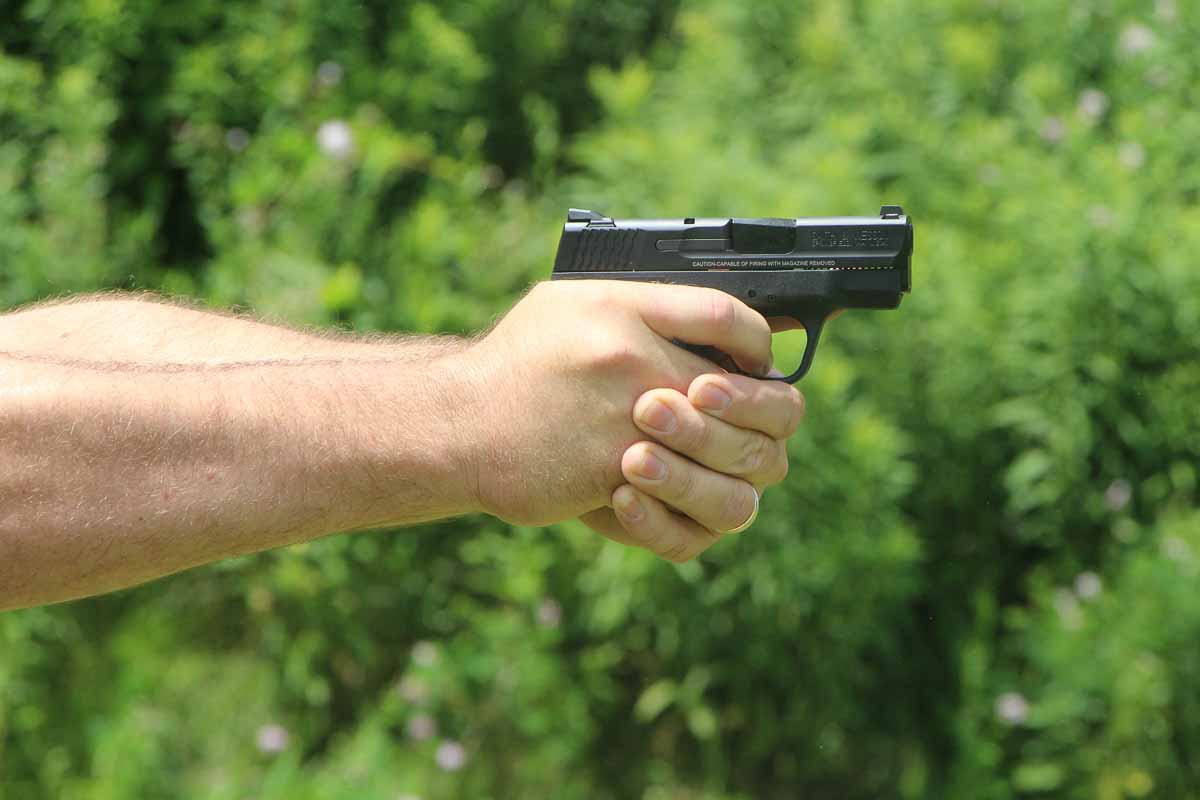
Fortunately, the M&P Shield has a good grip on recoil management. When shooting even the stout Federal BPLE +P+ load, I had no problem controlling the recoil and muzzle rise. Putting a magazine into an 8″ circle at 7 yards was easy no matter how fast I pulled the trigger.
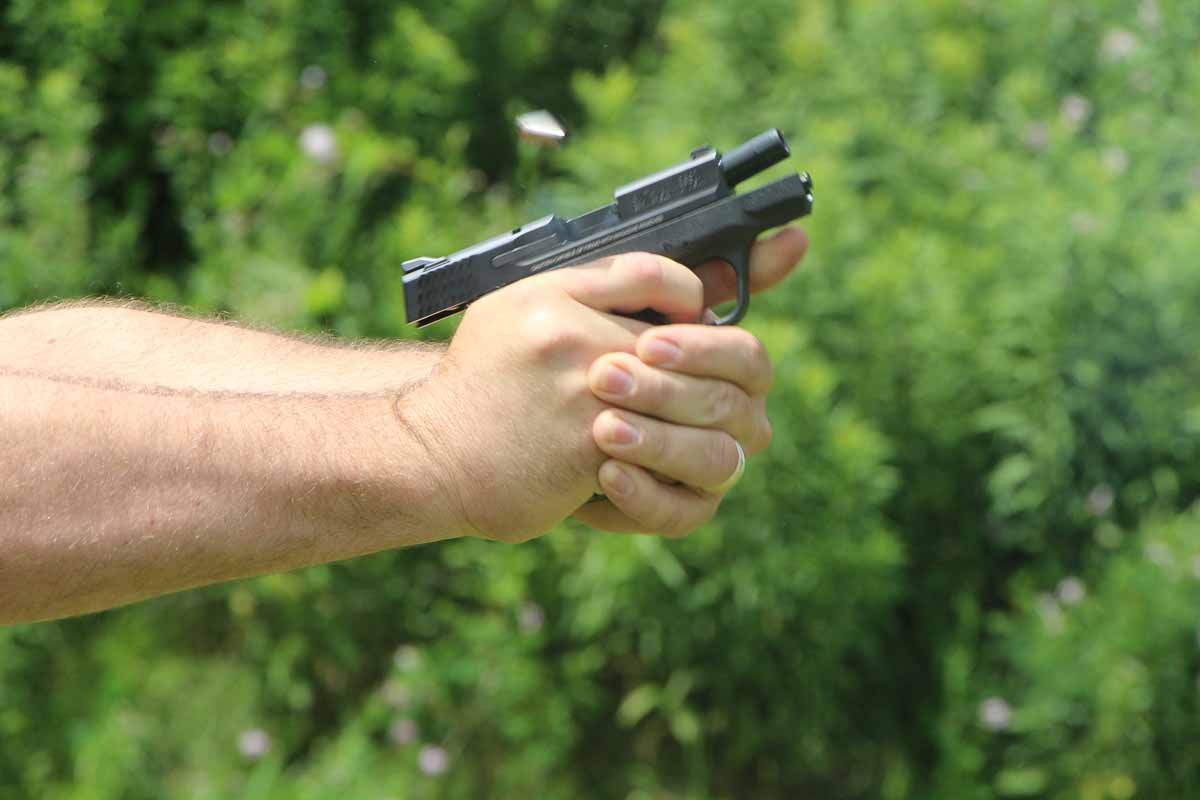
When shooting the Shield, there is only one thing I do not like about it: the narrowness of the backstrap at the web of the hand.
One of the gun’s major selling points is its thinness. It is one of the reasons why I really like it. However, the backstrap follows the general curve shape of the larger M&P pistols.
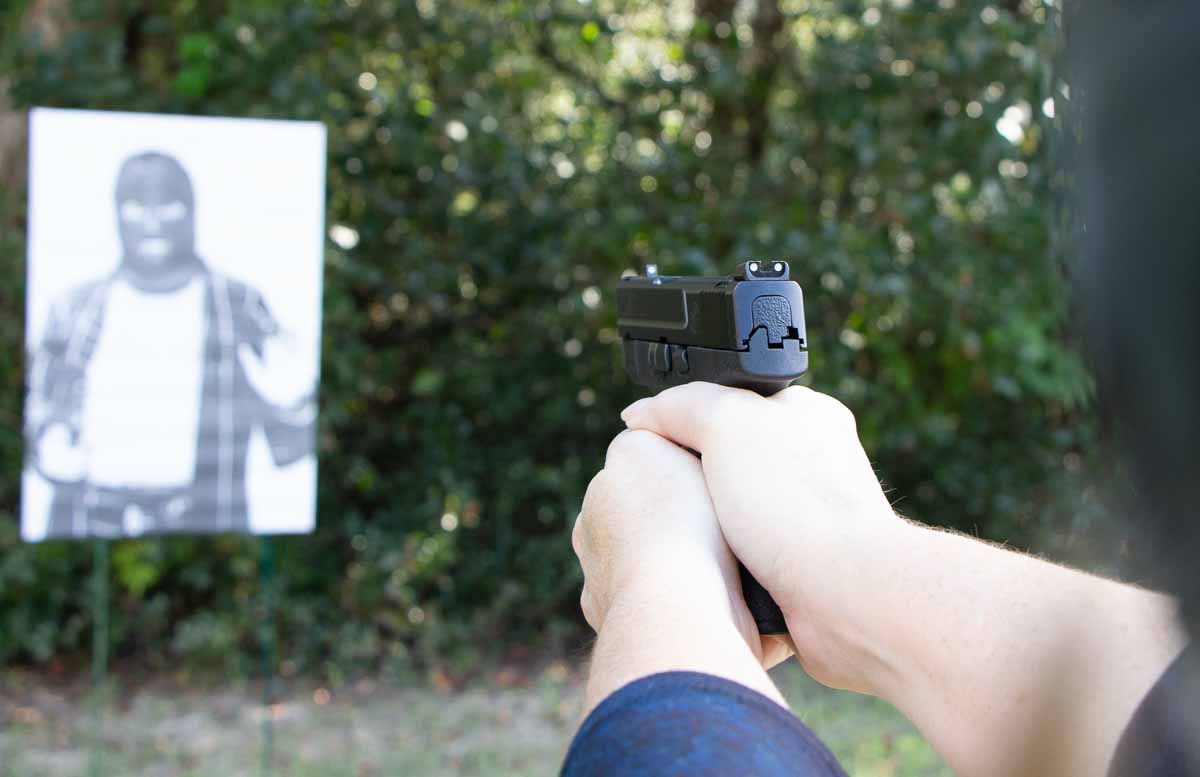
In the Shield, this creates a much more narrow point of interface between the gun and the hand. That means the recoil forces are directed into a narrower portion of the hand.
If Smith & Wesson retained the same overall thickness but did not taper the backstrap in so much, the recoil force would be spread over a wider portion of the hand. I personally think Walther knocked it out of the park with the PPS M2.
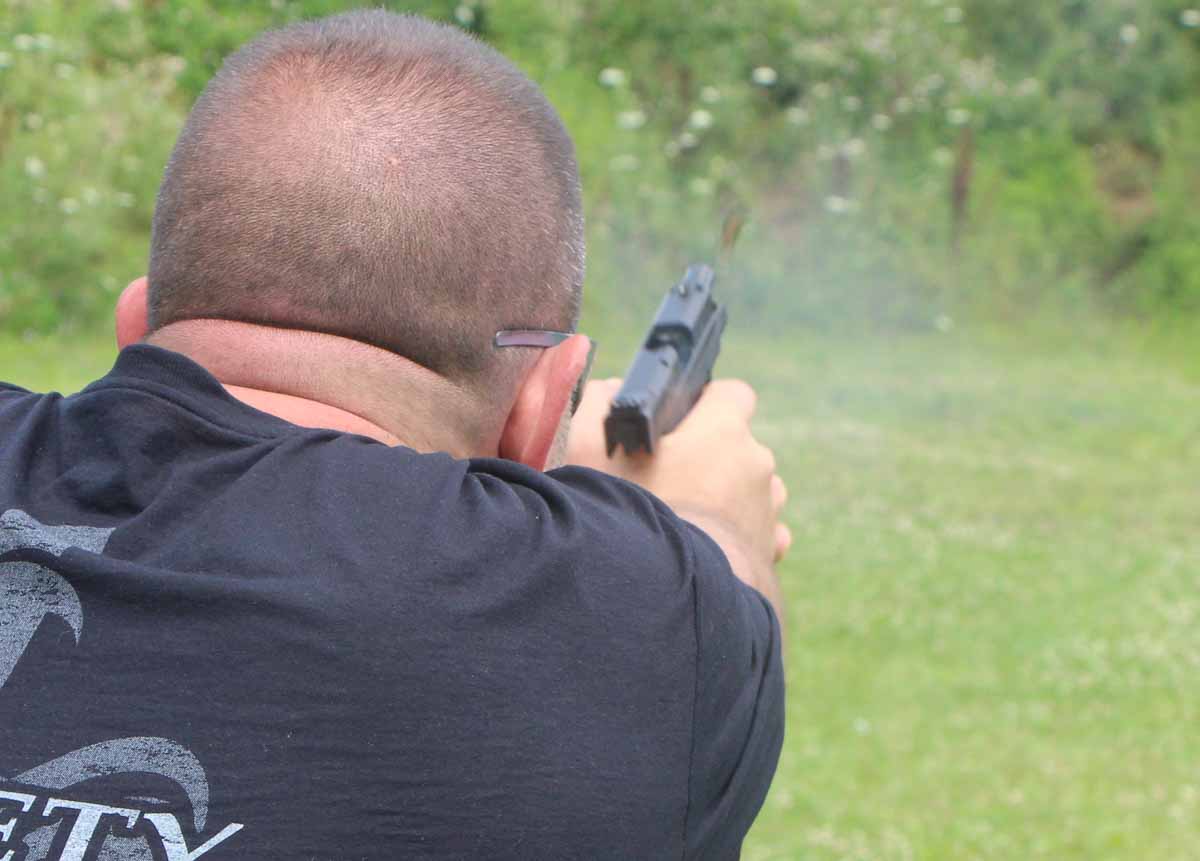
Is the recoil too much? Nope. Is it painful? Nope. I just think a small design change could have made the gun even more comfortable to shoot and handle without impacting its ability to carry or conceal.
Magazine Change Problems
Magazine changes are pretty standard with the flush-fitting (7 round) magazine. Press the button and it drops free. However, things get a little sticky with the extended magazine.
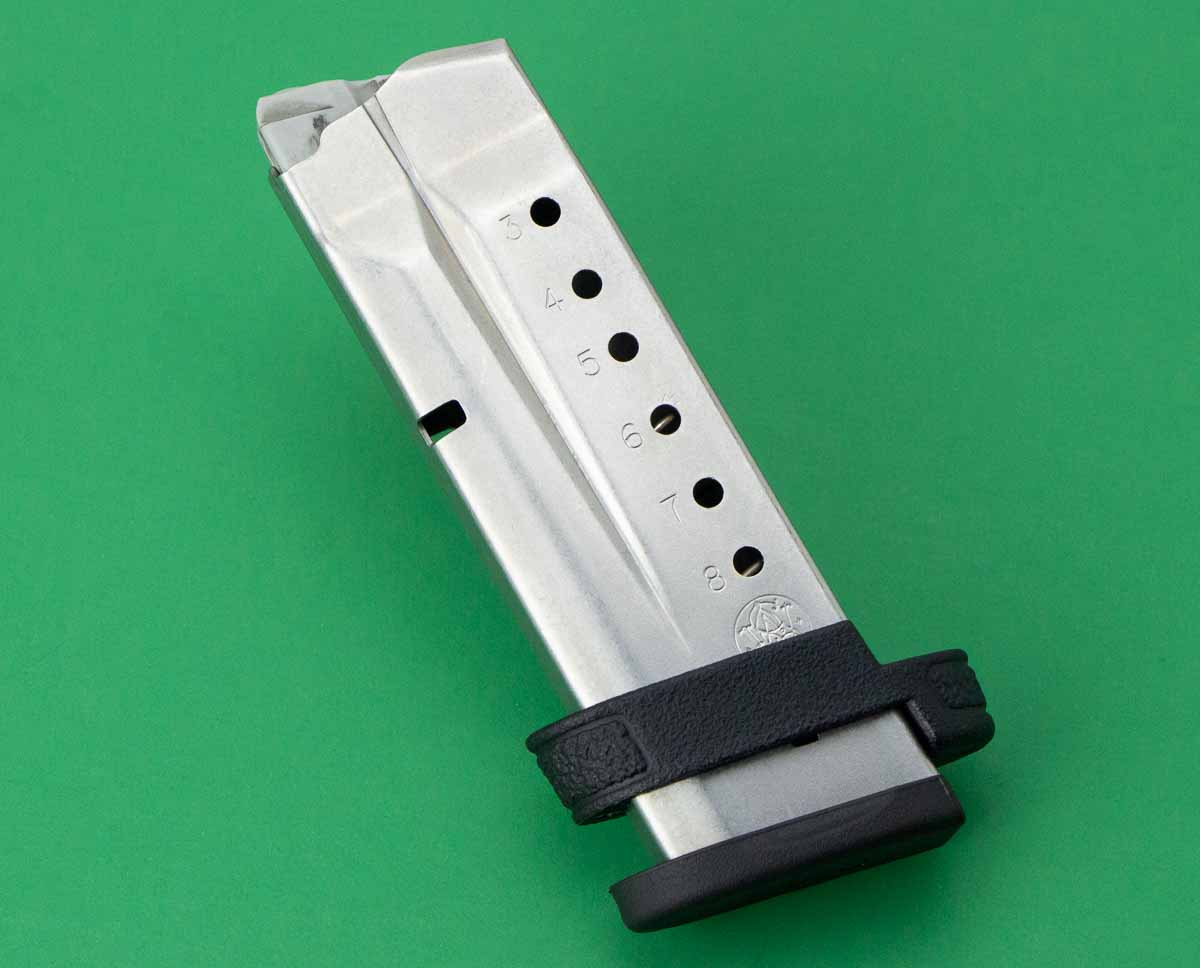
The extended mag (8 rounds) extends below the frame of the pistol. The magazine uses a standard base plate but adds a polymer sleeve to fill the gap between the base and the gun frame. In theory, this sleeve serves two purposes:
- it fills the area around the magazine body so the hand has something more substantial to grasp, and
- it acts as a spacer so that the magazine does not hit the ejector when the mag is slammed into place.
The sleeve does these things well but also introduces two problems.
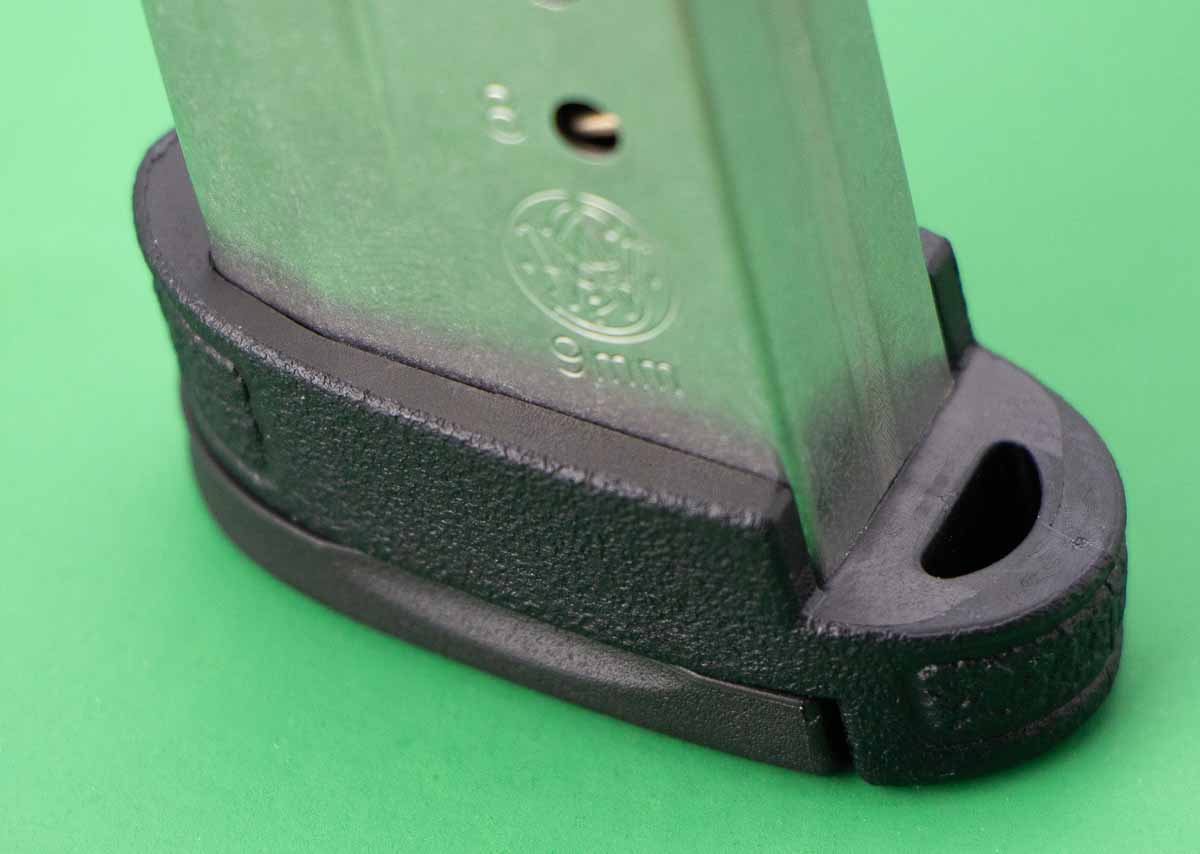
First, the sleeve adds a substantial amount of polymer at the rear of the magazine. This portion is essentially a continuation of the backstrap. While aesthetically pleasing, it has the unfortunate tendency to catch on the meaty portion of my shooting hand and not allow the magazine to drop free from the pistol.
Yes, it is unlikely I will need to change magazines in a self-defense shooting. However, if I need to, I do not want this spacer to make it harder than it should be. Don’t think I’m picking on the Shield; I had the same problem when I reviewed the Springfield Armory XD-S.
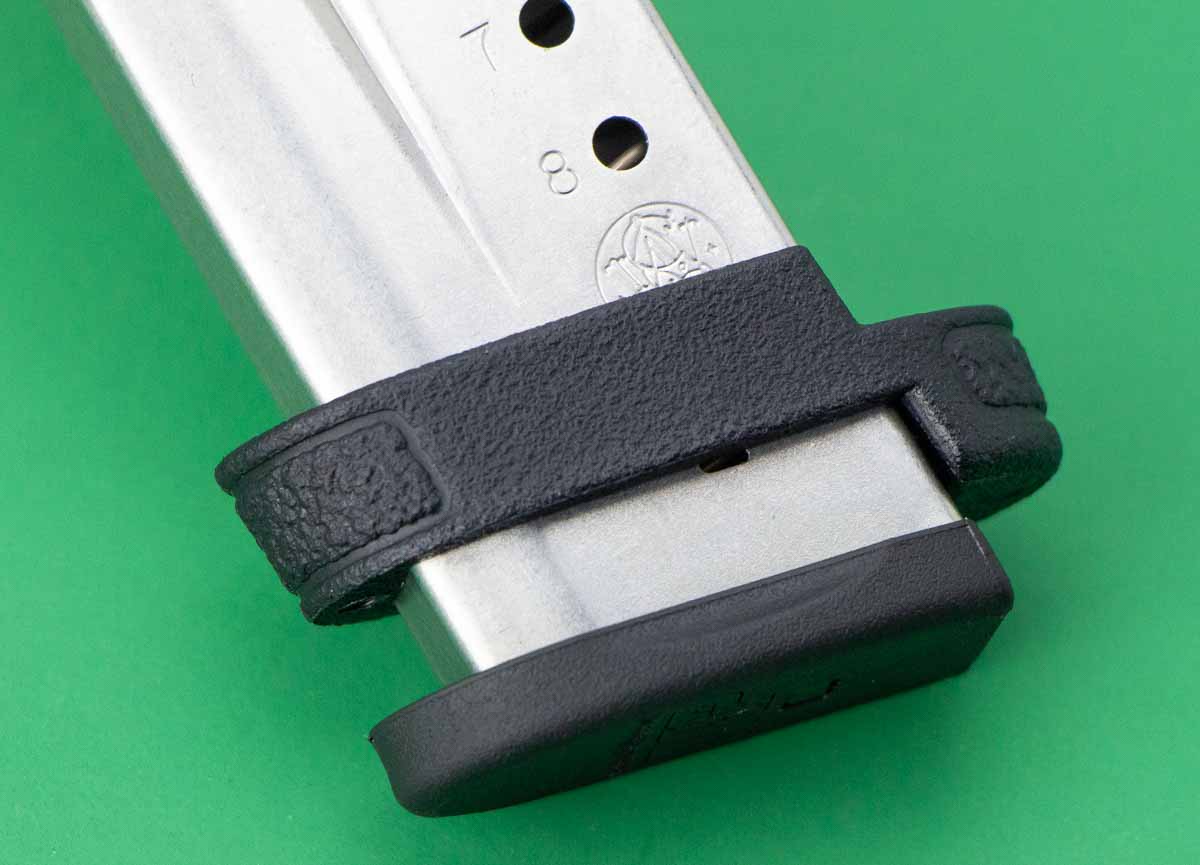
The second problem with the sleeve is that it can move when carried as a backup. If you carry the extended magazine anywhere but in the gun, the sleeve can move down the body of the mag. If you need to reload, that sleeve being out of position can prevent you from getting the magazine seated in the gun and back in the fight.
MagFIX
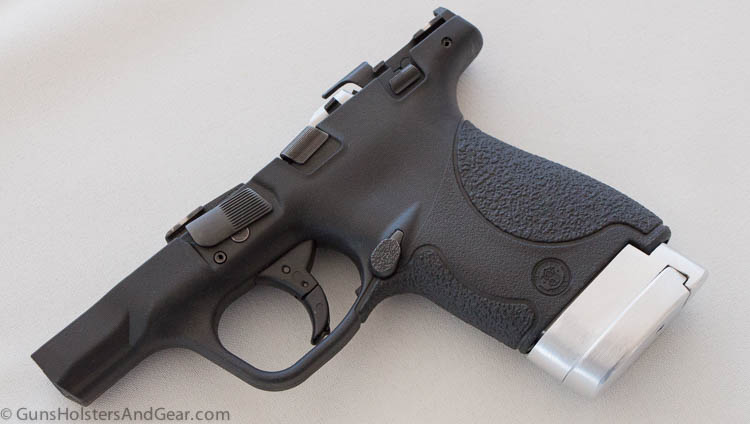
While we were first shooting the Shield, Carlson advised he had seen the same problems with the Shield in his training classes. After a student removed the factory spacer then broke a Shield ejector on a magazine change, Carlson realized another solution was needed.
Since then, Carlson developed and patented a new magazine base pad for the Shield called the MagFIX. This pad replaces the stock pad and sleeve with a unit that gives the shooter the benefits of the stock sleeve while not hanging up on the hand when reloading.
Additionally, the MAgFIX adds tiered wings on the base pad that allow the shooter to more easily strip the magazine from the pistol should a double feed occur.
Ammunition Performance
I’ve run a lot of ammo through this gun over the years. Here are the loads that I measured performance on:
| Velocity | Energy | |
| Federal BPLE 115 gr JHP +P+ | 1,157 fps | 342 ft-lbs |
| Federal HST 124 gr JHP +P | 1,085 fps | 324 ft-lbs |
| Federal Hydra-Shok 135 gr JHP | 958 fps | 275 ft-lbs |
| Hornady 135 gr Critical Duty | 929 fps | 259 ft-lbs |
| Hornady Critical Duty 135 gr +P | 1,010 fps | 306 ft-lbs |
| Hornady American Gunner 124 gr XTP +P | 1,036 fps | 296 ft-lbs |
| Hornady Critical Defense 115 gr FTX | 1,065 fps | 290 ft-lbs |
| HPR 115 gr JHP | 1,017 fps | 264 ft-lbs |
| HPR 124 gr JHP | 911 fps | 228 ft-lbs |
| Liberty Ammunition Civil Defense 50 gr JHP | 1,844 fps | 377 ft-lbs |
| Remington Golden Saber 124 gr JHP +P | 1,115 fps | 342 ft-lbs |
| Remington UMC 115 gr FMJ | 1,034 fps | 273 ft-lbs |
| SIG SAUER Elite Performance 115 gr FMJ | 1,050 fps | 282 ft-lbs |
| SIG SAUER Elite Performance V-Crown 124 gr JHP | 989 fps | 269 ft-lbs |
| SIG SAUER Elite Performance V-Crown 147 gr JHP | 863 fps | 243 ft-lbs |
| Speer Gold Dot 124 gr JHP | 996 fps | 273 fps |
| Speer Gold Dot 124 gr JHP +P (short barrel) | 1,078 fps | 320 ft-lbs |
| Winchester USA (white box) 115 gr FMJ | 1,040 fps | 276 ft-lbs |
| Winchester PDX1 Defender 124 gr +P | 1,092 fps | 328 ft-lbs |
Please note that I also ran Winchester PDX1 147 grain ammo through the gun. It ran 100% reliably as well. However, I managed to lose my notes with that ammo’s chronograph results.
Carrying
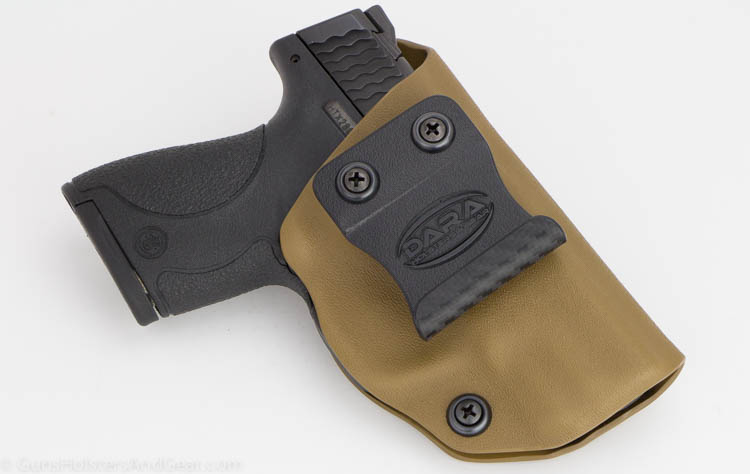
I was fortunate enough to be offered a pair of evaluation holsters from Dara Holsters for the Shield. Dara sent me out a pair of holsters: one IWB and one OWB. Click here to see the Dara Holster review.
Both of these rigs allow me to carry the Shield very easily with all kinds of clothing choices. If I’m working around the house, that typically means cargo shorts and a t-shirt. If I’m running around town, it might be something more formal: jeans and a polo. Even with dress slacks and a jacket, these rigs worked very well for me.
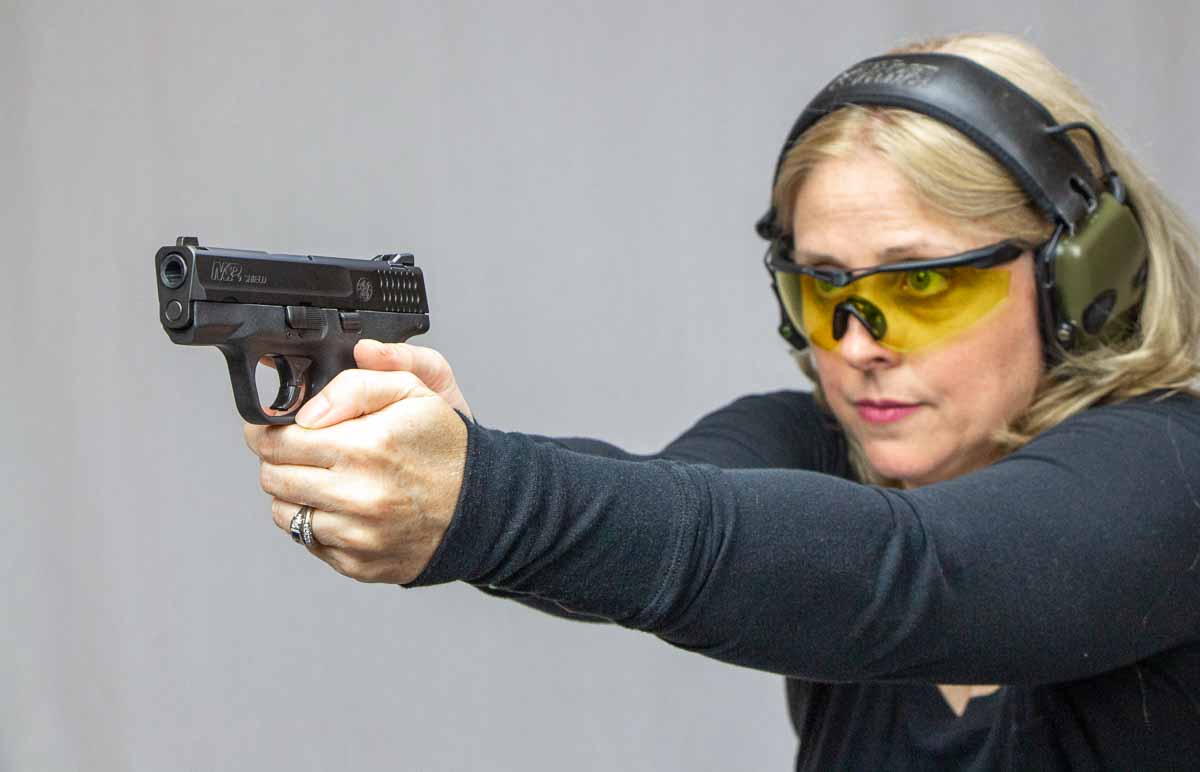
The Shield concealed nicely and was noticeably lighter than a fully loaded Glock 19 that I often carry.
I did try the Shield as a pocket carry gun but was displeased with it in this role. To me, the gun seemed too large in even the pockets of my cargo shorts. I’d recommend trying the Shield out in a gun store prior to buying if this is the way you want to carry it.
I’ve put together a list of M&P Shield holsters here. Also, I reviewed the A.R.C. holster from Blackhawk with the M&P Shield here.
Variants
Since the first Shield rolled off the Smith & Wesson manufacturing line, the company upgraded the pistol to keep it on the cutting edge of self-defense technology.
Currently, Smith & Wesson offers three models of Shield: the original gun reviewed here, the M2.0 and the Plus.
The Shield M2.0 enjoys many of the enhancements that the full-size M&P pistols received including an improved trigger and more aggressive grip texture. It is extremely similar to the original.
The S&W Shield Plus, on the other hand, offers improved capacity and a further improved trigger. Flush-fitting magazines hold 10 rounds while the extended mags hold 13. Smith & Wesson also upgraded the trigger to a flat-faced switch with improved reset.
Final Thoughts
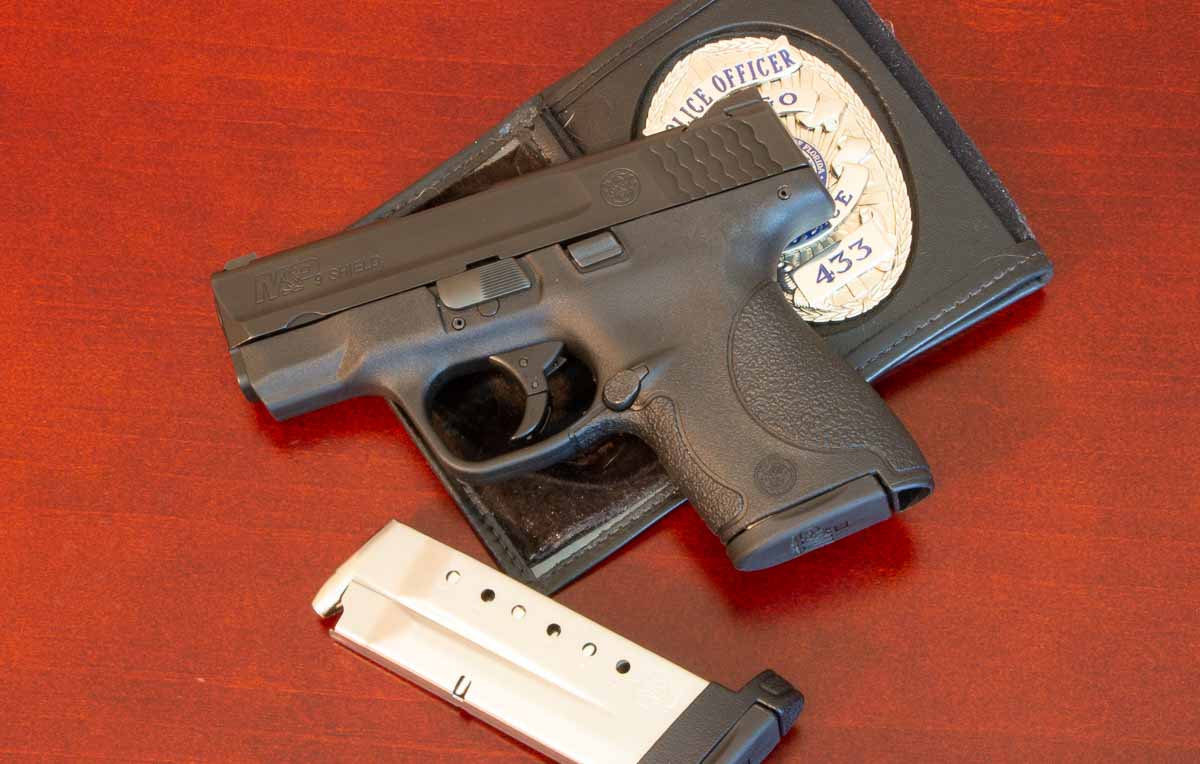
The Smith & Wesson Shield is just about the perfect single stack 9mm pistol. For some people, it will be a perfect choice, but while I like it a great deal, it comes up a little short of complete perfection in my estimation.
What I Liked
First, the gun ran 100% will every kind of ammunition I threw at it. Take a look at the spec chart above and you can see I fed it standard pressure through +P+, all kinds of bullet types and even bullet weights from 50 grains through 147 grains.
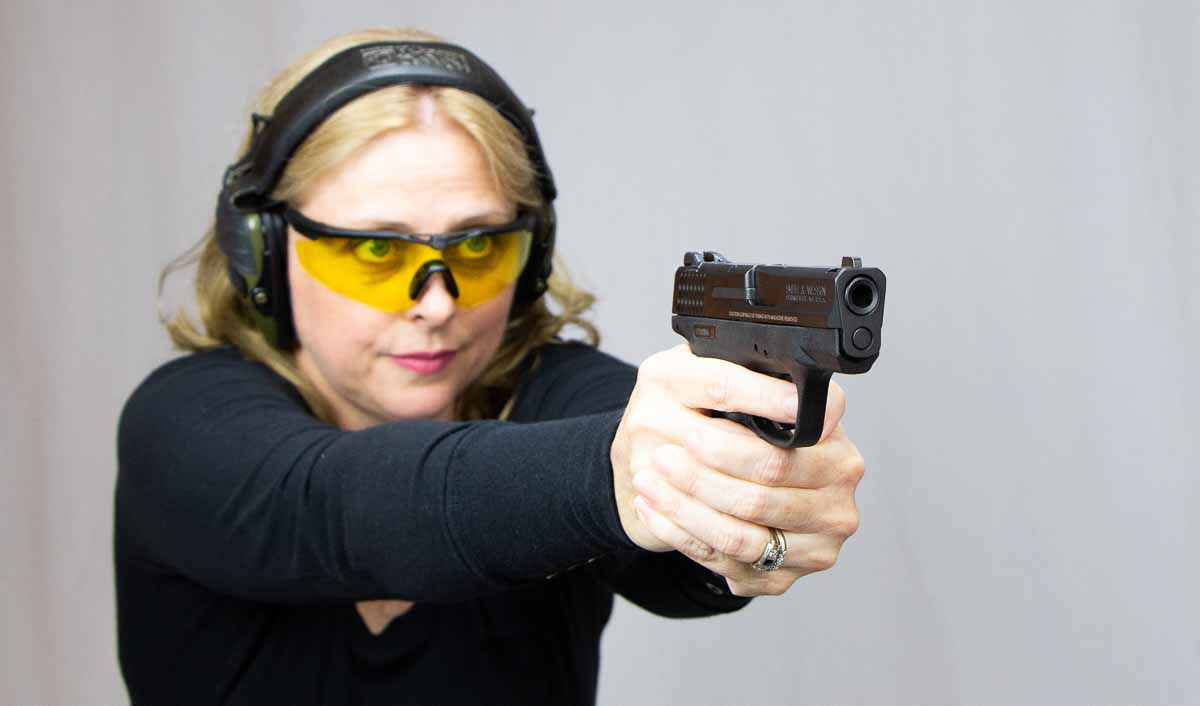
Secondly, the gun was more than accurate enough for self-defense. Ringing a gong at 50 yards was no problem with this compact pistol. Close in, the gun was extremely accurate as well. Recoil was moderate and allowed for fast follow-up shots.
Third, the gun is very reasonably priced. The suggested retail price when launched was $449. With the new models out, Smith & Wesson dropped the price to a mere $385 to make it one of the best values in concealed carry today.
Lastly, the guns are thin, light and easy to conceal. If you are looking for a CCW gun, the 9mm Shield is one of the easier guns to carry.
Where the Shield Can Improve
There are only two things that I would like to see Smith & Wesson change about the pistol. The first is a slight redesign of the backstrap to spread out the felt recoil impulse.
The second is to improve the extended magazine situation. For me, the obvious solution is the MagFIX, and Smith & Wesson should use that design or something very similar to it. But, the existing sleeve is a problem that could really get someone in a jam. Update these two things and this is a five-star gun.
Bottom Line
I strongly recommend the Smith & Wesson M&P9 Shield without the thumb safety to anyone needing a CCW or personal defense handgun.

Where to buy the Smith & Wesson Shield
The original Shield has been updated to the Shield M2.0. and the higher capacity Shield Plus. The new guns are nothing but improvements on the top-tier performance of the original. I recommend using one of our affiliate links below to purchase one.
- Palmetto State Armory: Shield M2.0, Shield Plus, Shield Plus EDC Kit
- Guns.com: Shield M2.0
- Sportsman’s Guide: Shield Plus
Last Update: October 14, 2024
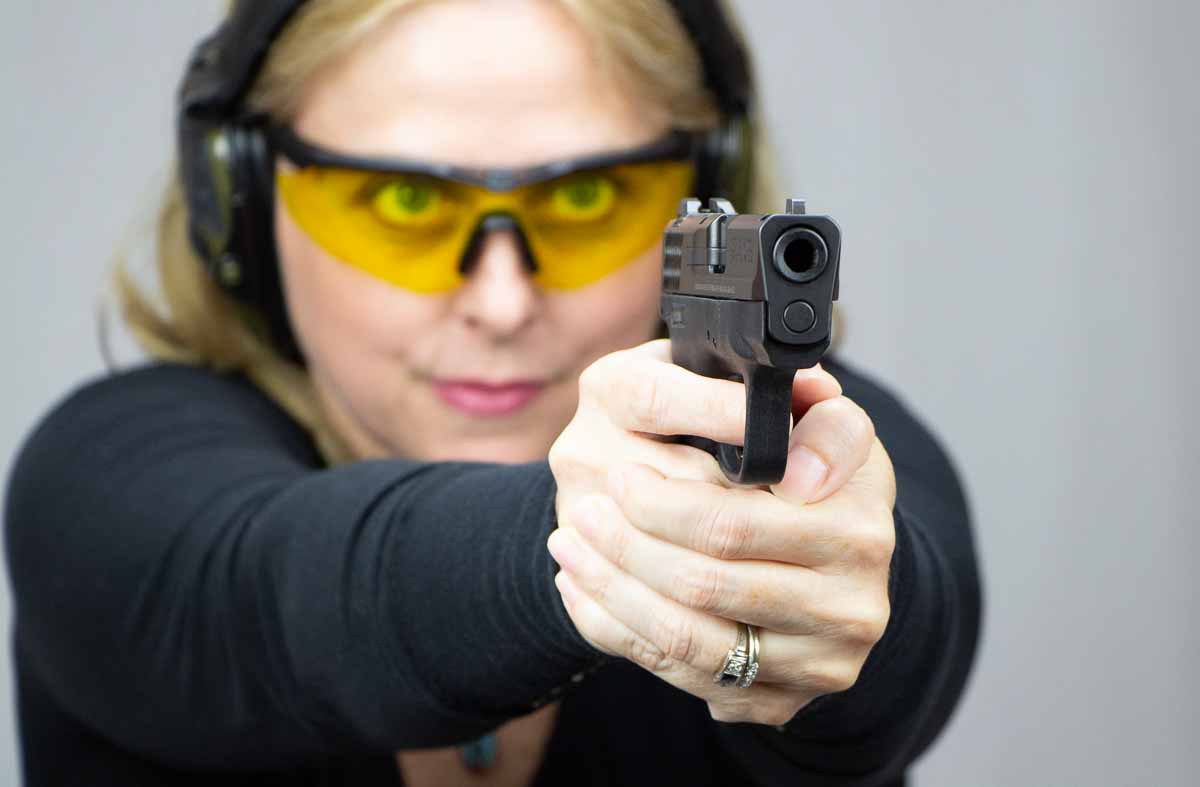
31 replies on “Smith & Wesson Shield 9mm Review”
I thought shooting +p+ ammunition in the shield was highly forbidden
???
Smith & Wesson may invalidate the warranty due to the increased wear on the gun from a steady diet of +P+ ammunition, but it is not illegal ammo. The Federal BPLE 115 gr JHP +P+ has been in successful use since the 1970’s. I’ve been using it for only about 20 years.
+P+ ammo is simply a designation saying that the pressures exceed those set by SAAMI for +P 9mm ammo loads. Of course, SAAMI does not have standards for a lot of cartridges, so not being SAAMI-spec does not mean the ammo is dangerous per se.
A quality firearm should be able to handle +P+ 9mm ammunition. If I had some Winchester 127 grain +P+ on hand, I would have run it also in this pistol. That said, I’d not run it in a Taurus or other handgun I had safety concerns about.
-Richard
I realize that it’s legal as I have about 300 rounds of the ranger +p+ stuff for my Glock 19, I thought Smith and wesson said something about not using +p+ in the shield.
Every manufacturer will void your warranty for shooting +P+ ammunition Including Glock. That is not special to the Shield or Smith & Wesson.
It appears that a portion of the rounded back side of the magazine spacer can be cut off, allowing it to drop free. And any number of things can be done to prevent the spacer from sliding up.
i have the shield in 9mm and xds in 45acp. can’t see any difference except for the recoil in the 45acp. both are great pistols.
As others have said, fear of having a thumb safety is not an issue. The safety is small and isn’t going to engage accidentally. If your Shield has a safety and you have no use for it, just ignore it.
I put the safety on when holstering, then as soon as it’s in the holster, the safety goes off.
It is too small to rely on disengaging it during a draw.
Could S&W have done a better job on the extended magazines spacer ? Yes, but just secure it and be done with it.
I have no issue with the sliding spacer on the extended mags, if secured against the base plate.
Some contact cement or epoxy, and they aren’t going to move around. Mine haven’t with 3 years of carry.
I’m still trying to picture how the spacer “hangs up on your hand” when removing a magazine.
It’s no different than a magazine that has a a thicker base pad.
Re: Glue on the 8 cartridge capacity adapting spacer… then how does one remove the baseplate for magazine maintenance, cleaning, spring and follower replacement?
I have two Shield 9’s, one the std version with Apex trigger (no manual safety, the other a Performance Center, stock (has manual safety). Zero malfunctions, ever, either one. Both wear Viridian R5 Reactor ECR Green Lasers. +1 on ejecting issue with 8 mag (fat palm interference with drop-free). Never use manual safety, and it has never “accidentally engaged”.